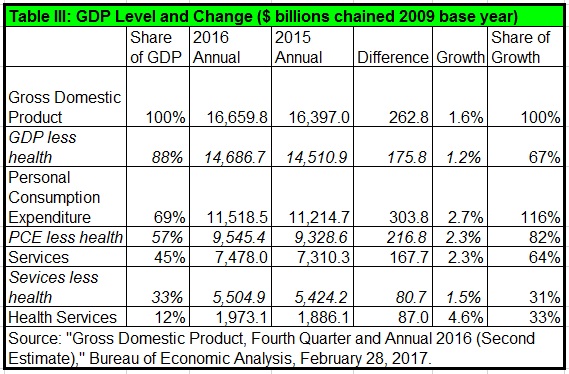For those (like me) concerned about how
much health spending continues to increase after Obamacare, today’s second report
of fourth quarter Gross Domestic Product shows concern is still warranted.
Because of revisions to the advance estimate, health spending accounted for a
greater share of GDP than we had thought.
Overall, real GPD increased 1.8 percent on
the quarter, while health services spending increased 5.6 percent, and
contributed 36 percent of real GDP growth. Growth in health services spending
was much higher than growth in non-health services spending (0.3 percent) and
non-health personal consumption expenditures (2.4 percent). However, the implied
annualized change in the health services price index increased by just 1.6
percent, lower than the price increase of 2.4 percent for non-health services,
2.0 percent for non-health PCE, and 2.1 percent for non-health GDP.
(See Table I below the fold.)
Longer term, growth in health services
spending is also high, having grown 4.8 percent since 2015 Q4, versus 1.5 percent
for non-health services, 2.6 percent for non-health PCE, and 1.5 percent for
non-health GDP (Table II). Implied inflation for health services was in line
with GDP.
However, the full-year GDP for 2016 also
shows disproportionately high growth in health spending, which rose 4.6 percent
versus just 1.5 percent for non-health services spending, 2.3 percent for
non-health personal consumption expenditures, and 1.2 percent for non-health
GDP (Table III).
Technical note: Until the July
29, 2016 entry on the GDP release, I discussed nominal GDP growth. As of August
26, 2016, these updates discuss real GDP growth, in line with the way most
media cover GDP. However, as of the October 28, 2016 entry, I add a column that
estimates changes in the price indices, calculated from the news release.
When I discuss health services in these
quarterly GDP releases, I mean only health services. I do not include purchases
of medical equipment, or facilities construction.
While I include Medicare and
Medicaid, I do not include Veterans Health Administration or other government
benefits. So, these dollar figures undercount the amount of
our economy consumed by the government-health complex.
(See: Measuring the Economy: A
Primer on the GDP and the National Income and
Product Accounts, Bureau of
Economic Analysis, October 2014, pages 5-2 and 5-3; Micah B. Hartman, et
al., “A Reconciliation of Health Care Expenditures in the National Health
Expenditures Accounts and in Gross Domestic Product,” Research Spotlight, Survey
of Current Business, September 2010, pages 42-52.)
Professor Christopher Conover explains why
some scholars de-emphasize CPI and medical CPI as appropriate measures of
inflation for health care, preferring Personal Consumption Expenditures (PCE),
which I discuss here. The PCE price index is updated only quarterly, which is
why I interpolate from monthly GDP releases. However, health spending in PCE is
only services. Prices for goods, such as drugs and medical devices are not
considered here.





No comments:
Post a Comment